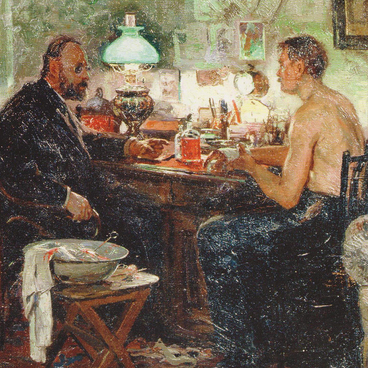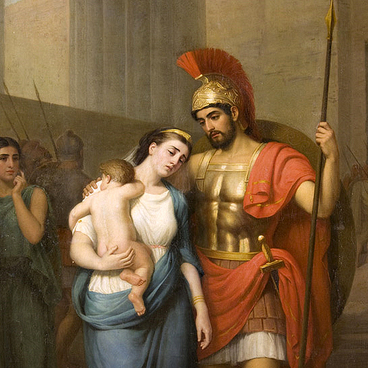Vera Pestel was born in 1887 in Moscow. In the 1900s, she attended the private studio of one of the French artists and the Sunday drawing classes of the Imperial Stroganov Central School of Decorative and Applied Arts. In 1906–1907, Pestel studied at the School of Drawing and Painting of Konstantin Yuon and Ivan Dudin. During a trip to France in 1912, she attended Académie de La Palette led by Henri Le Fauconnier and Jean Metzinger. Vera Pestel’s friends and associates were Kazimir Malevich, Lyubov Popova, Nadezhda Udaltsova.
Having returning from France, Vera Pestel worked in the Free Collective Workshop on Ostozhenka Street with Vladimir Tatlin, one of the major figures of the Russian avant-garde who was the founder of constructivism.
The portrait of Vladimir Tatlin with a pandura, painted by V. Pestel, serves as a kind of manifesto of avant-garde painting. In the painting, the person himself, his face and figure consist of color planes, geometric shapes and lines.
During that period, Vera Pestel was fond of shape experiments. However, unlike many of her colleagues, she was not internally convinced of the correctness of the path followed by avant-garde art. This was evidenced by her diaries, where the artist was increasingly referring to the “old masters” recalling Rembrandt. In 1918, Pestel moved away from the “left” art and returned to object painting.
An interesting story of attribution is connected with Tatlin’s portrait. The painting came to Chelyabinsk from the State Russian Museum and for a long time was considered a still life called ‘Cubism. Musical instruments’. In the mid-1990s, the Moscow researcher of the Russian avant-garde Georgy Kovalenko discovered an old postcard in which the painting was indicated to be precisely a portrait of Tatlin. The geometric shapes, previously indistinguishable by experts and viewers, formed the figure of a celebrated artist.
The geometric system of the portrait also includes the construction of a counter-relief, a three-dimensional painting of Tatlin himself. The image of a musical instrument in the artist’s hands is connected with his passion for the Ukrainian folk songs as Tatlin sang accompanying himself on a bandura of his own making. He did this more than once in the workshop of the artist Vera Pestel, where the portrait was painted in 1915. The attribution of the painting has become one of the most important events in the history of the Chelyabinsk State Museum of Fine Arts, especially since the portrait by Pestel is the only classic piece of the Russian avant-garde in the collection.
Having returning from France, Vera Pestel worked in the Free Collective Workshop on Ostozhenka Street with Vladimir Tatlin, one of the major figures of the Russian avant-garde who was the founder of constructivism.
The portrait of Vladimir Tatlin with a pandura, painted by V. Pestel, serves as a kind of manifesto of avant-garde painting. In the painting, the person himself, his face and figure consist of color planes, geometric shapes and lines.
During that period, Vera Pestel was fond of shape experiments. However, unlike many of her colleagues, she was not internally convinced of the correctness of the path followed by avant-garde art. This was evidenced by her diaries, where the artist was increasingly referring to the “old masters” recalling Rembrandt. In 1918, Pestel moved away from the “left” art and returned to object painting.
An interesting story of attribution is connected with Tatlin’s portrait. The painting came to Chelyabinsk from the State Russian Museum and for a long time was considered a still life called ‘Cubism. Musical instruments’. In the mid-1990s, the Moscow researcher of the Russian avant-garde Georgy Kovalenko discovered an old postcard in which the painting was indicated to be precisely a portrait of Tatlin. The geometric shapes, previously indistinguishable by experts and viewers, formed the figure of a celebrated artist.
The geometric system of the portrait also includes the construction of a counter-relief, a three-dimensional painting of Tatlin himself. The image of a musical instrument in the artist’s hands is connected with his passion for the Ukrainian folk songs as Tatlin sang accompanying himself on a bandura of his own making. He did this more than once in the workshop of the artist Vera Pestel, where the portrait was painted in 1915. The attribution of the painting has become one of the most important events in the history of the Chelyabinsk State Museum of Fine Arts, especially since the portrait by Pestel is the only classic piece of the Russian avant-garde in the collection.



